Price determination
1/86
There's no tags or description
Looks like no tags are added yet.
Name | Mastery | Learn | Test | Matching | Spaced |
|---|
No study sessions yet.
87 Terms
What is a market?
A voluntary meeting of buyers and sellers. Both buyer and seller are willing to exchange.
What does a demand curve show?
The relationship between price and quantity demanded
What is the law of demand?
as price increases, demand decreases
What causes movements along the demand curve?
changes in price
What does an increase in price cause?
A constriction in demand
What does a decrease in price cause?
An expansion in demand
What is market demand?
The quantity of a good or service that all the consumers in a market are willing to buy at different market prices.
What causes shifts in the demand curve?
PAPPITS;
Population size
Advertising campaigns
Price of substitute goods
Price of complementary goods
Income
Trends/preferences
Speculation
What is a substitute good?
A good in competing demand which can be used in place of the other good. For example, Pepsi and Coca Cola
What is a complementary good?
A good in joint demand, or a good which is demanded at the same time as the other good. For example, staples and stapler.
What is a normal good?
A good for which demand increases as income rises and demand decreases as income falls. For example, iPhone and Prada.
What is an inferior good?
A good for which demand increases as income rises and demand increases as income falls. For example, Primark.
What is a substitute good?
A good in competing demand which can be used in place of the other good.
What are the violations of the law of demand?
Speculative demand
Veblen goods
Giffen goods
What is speculative demand?
When the price of assets increases and people speculate that future prices will rise further. This likely increases demand and price further, for example, Bitcoin.
What are Veblen goods?
Goods of exclusive or ostentatious consumption (snob or positional goods), for example, Rolex improves status.
What are Giffen goods?
A type of inferior good that people consume more of as the price increases. For example, in Victorian Britain, if the price of bread increased people had no alternatives. Instead, they reduced purchases of expensive goods and bought more bread.
What is price elasticity of demand (PED)?
The responsiveness of quantity demanded to a change in price.
What is the formula for PED?
Percentage change in quantity demanded of a good / Percentage change in price of a good

What is price elastic demand?
The responsiveness of quantity demanded changes proportionately more than price. For example, if price increases by 25%, quantity demanded decreases by 50%.
What is price inelastic demand?
The responsiveness of quantity demanded changes proportionately less than a change in price. For example, if price increases by 25% quantity demanded decreases by 12.5%.
What is the sign of PED?
Negative
What is total revenue?
The money received by a firm for selling its total output (Selling price x quantity). It is shown by the area under the demand curve.
What is the impact of PED on firms?
Increasing the price of elastic goods will decrease total revenue as the quantity changes proportionately more than the price. Increasing the price of inelastic goods will increase total revenue as the quantity demanded changes proportionately less than the price.
Describe a perfectly inelastic graph
Number = 0
Sign = Negative
The demand curve is vertical. ![]()
What does perfectly inelastic mean?
Price change causes no effect on demand.
Describe a price inelastic PED graph
Number = 0 < x < 1
Sign = negative
Demand curve is steep
Describe a unitary elastic PED graph
Number = 1 (ignoring negatives)
Sign = negative
The demand curve is 45 degrees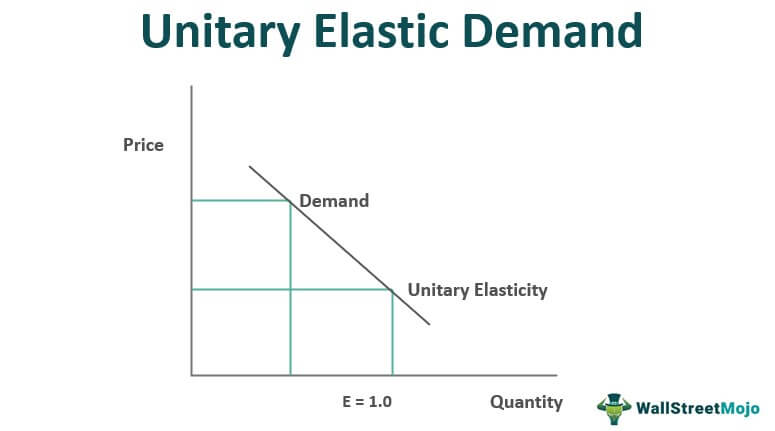
What does unitary elastic mean?
Price change causes a proportionately equal change in quantity demanded.
Describe a price elastic PED
Number = >1 (ignoring negatives)
Sign = negative
The demand curve is shallow (almost horizontal)
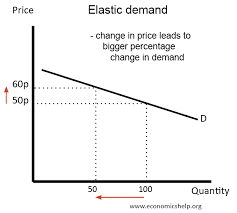
Describe a perfectly elastic PED graph
Number = infinite
Sign = negative
Demand curve is horizontal
What does perfectly elastic PED mean?
Price change causes a proportionately infinite change on quantity demanded
What factors influence PED?
MINTSA
Market application
Income proportion
Necessity or luxury
Time period
Availability of substitutes
Addictive
How does market application affect PED?
When the price rise is applied to the whole market, the PED is generally inelastic.
When the price is only applied to a few firms in the market, PED tends to be elastic.
How does income proportion affect PED?
When the proportion of income spent on the good is low, PED is inelastic.
When the proportion of income spent on the good is high, PED is elastic.
How does necessity or luxury affect PED?
When the good is a necessity, PED is inelastic.
When the good is a luxury, PED is elastic.
How does the availability of substitutes affect PED?
When there are few or weak substitutes, PED is inelastic.
When there are many or close substitutes, PED is elastic.
How does the time period affect PED?
In the short-run, PED is inelastic as firms are limited by their fixed factors of production.
In the long-run, PED is elastic as all factors of production are variable.
How does addictiveness affect PED?
if the good is addictive, PED is inelastic.
What is income elasticity of demand(YED) ?
The responsiveness of the quantity demanded to a change in income.
It is used to predict how much quantity will expect to sell when incomes change.
What is the formula for YED?
YED = Percentage change in quantity demanded of a good / Percentage change in income

What does a positive YED mean?
It is a normal/luxury good
What does a negative YED mean?
It is an inferior good
What does a YED of +0.06 tell us and what does a YED of -0.8 tell us, respectively.
+0.06 = The good is normal and inelastic (less responsive)
-0.8 = The good is inferior and inelastic
What does a YED of +1.9 tell us and what does a YED of -2.3 tell us, respectively.
+1.9 = The good is normal and elastic (more responsive)
-2.3 = The good is inferior and elastic (less responsive)
What are the types of normal goods?
Normal necessity goods
Normal luxury goods
What numbers indicate a normal necessity good?
Number between 0 and +1, for example, milk.
What numbers indicate a normal luxury good?
Number a lot greater than +1, for example, Tesla.
What is cross-price elasticity of demand (XED)?
The responsiveness of the quantity demanded of good A in relation to a change in price of good B.
What is the formula for XED?
XED = Percentage change in quantity demanded of good A / Percentage change of good B

What does a positive XED mean?
Substitute goods; as the price of good A rises, the quantity demanded of good B rises OR as the price of good A falls, the quantity demanded of good B falls.
What does a negative XED mean?
Complementary goods; as the price of good A rises, quantity demanded of good B falls OR as the price of good A falls, quantity demanded of good B rises.
What does an XED greater than 1 (elastic) mean?
They strong complementary/substitute goods
What does an XED less than 1 (inelastic) mean?
They are weak complementary/substitute goods
What is supply?
The quantity of goods or services that firms are willing and able to provide markets at a given price.
They enter the market for profit.
What is the relationship between quantity and price?
There is a positive relationship between price and quantity supplied by firms.
Why is there a positive relationship between price and quantity supplied by firms?
Price rises increase the opportunity costs of not supplying
Price rises means inefficient suppliers can cover their costs and therefore are willing to supply.
What does the law of supply state?
Producers and sellers aim to maximise their profits and therefore supply more when prices increase.
In which direction does the supply curve slope?
Upwards; positive relationship between price and quantity
What are the conditions of supply (factors that shift the supply curve)?
CREWLIST
Cost of borrowing
Raw material costs
Energy costs
Wage costs
Labour productivity
Indirect taxes
Subsidies
Technology improvements
What is an indirect tax?
A tax on spending imposed on firms (e.g VAT, cigarette duty, excise duty) that can be passed onto consumers.
What is a subsidy?
A government grant given to firms to reduce costs and encourage supply.
Subsidies shift the supply curve rightwards as it decreases the cost of production for firms and therefore they receive more profit per unit so they increase supply at each given price level.
What is price elasticity of supply (PES)?
The responsiveness of the quantity supplied to a change in price.
What is the formula of PES?
PES = Percentage change in the quantity supplied / Percentage change in price.
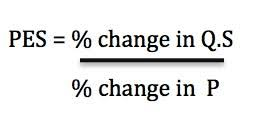
What does an inelastic PES mean?
The quantity supplied changes proportionately less than price.
What does an elastic PES mean?
The quantity supplied changes proportionately more than price.
What is the sign for PES?
Always positive
What are the factors affecting the price elasticity of supply?
TEASEA
Time
Ease of switching production
Ability to stockpile
Spare capacity available
Ease of entering market/lack of barriers
Availability of raw materials
What is stockpile?
Storage space
When is a market in equilibrium?
Supply = demand
What happens at equilibrium in terms of price and quantity?
There is no tendency for price or quantity to change
What is the equilibrium price?
Where every good that a producer wants to sell will be sold but there will also be no extra demand.
What does it mean when a market is in disequilibrium?
A price where supply does not equal demand.
What is derived demand?
Demand that occurs when a good is necessary for the production of other goods. For example, demand for driving instructions from driving lessons.
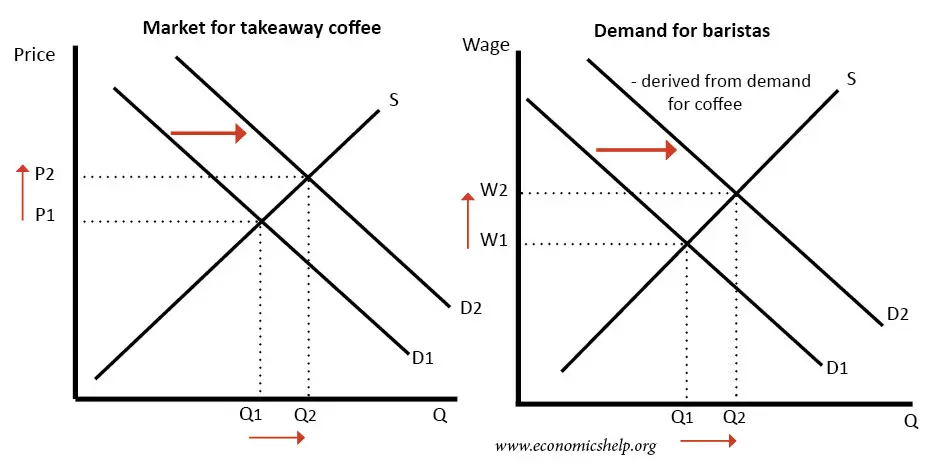
What is joint demand?
Joint demand is when two goods are demanded together (also called complementary goods)
What is composite demand?
Demand for a good which has more than one use.
An increase in the demand for one good leads to a fall in supply of the other.
For example, oil can be used to produce plastics and petrol.
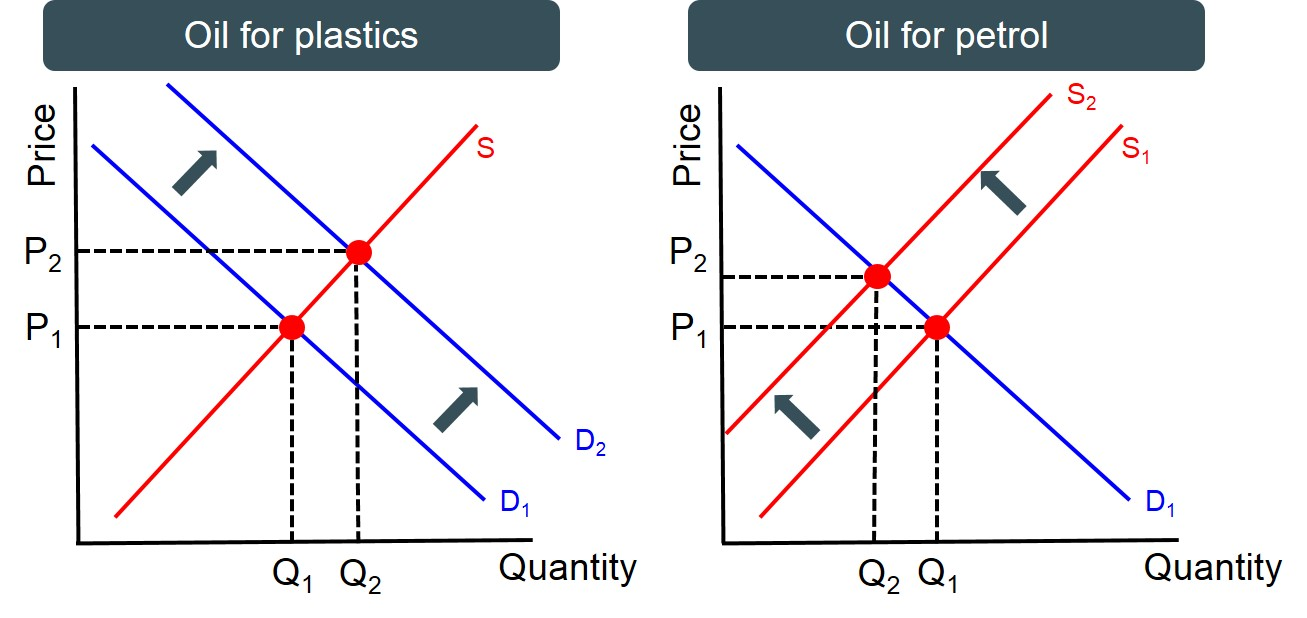
What is joint supply?
When the production of one good increases the supply of a by-product e.g lamb and wool
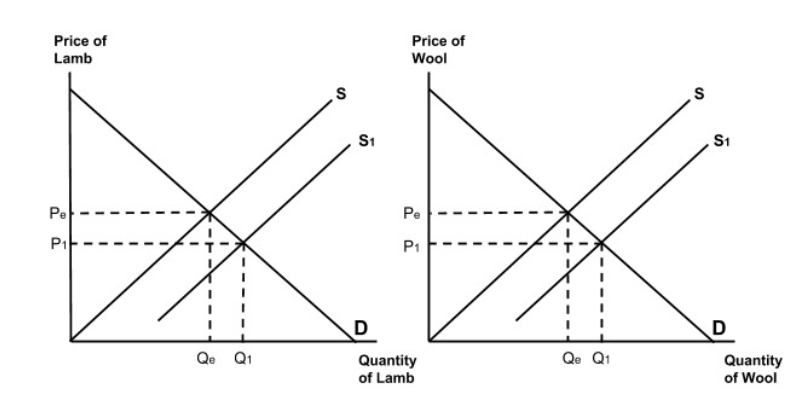
What is meant by the ‘invisible hand’?
Letting businesses and consumers figure it out themselves; in an impersonal way
What are the three functions of the price mechanism?
Signallling
Incentive
Rationing
What is the signalling function of the price mechanism?
Prices provide information to buyers and sellers. For example, expensive empty tables in a restaurant means price are too high.
What is the incentive function of the price mechanism?
Prices create incentives for people to alter their economic behaviour. For example, higher prices allows firms to increase production by providing higher profits.
What is the rationing function of the price mechanism?
If there is high demand for a good/service and its supply is limited, then the price will be high. Supply of the good will be restricted to those that can afford to pay a high price, whilst those who cannot are discouraged from purchasing and ration away their demand.
This applies for goods that are in low demand but in high supply - they will have a low price and many will be sold.
What are the advantages of the price mechanism?
Resources will be allocated efficiently to satisfy consumer needs and wants
Price mechanism can operate with no one having to regulate it - the ‘invisible hand’
Consumers decide what is and isn’t produced
Prices are kept to their minimum
What are the disadvantages of the price mechanism?
Inequality in wealth and income is likely
Certain goods will be under or over produced for (merit and demerit goods) e.g alcohol
Some goods won’t be produced at all if there is no profit to be made - public goods e.g streetlamps.
How do you explain a change in equilibrium? SESIRE
Shift
e.g D shifts right, income increases
Excess
excess demand before the price change
Signalling
product selling out quickly signals to the firm that the price should increase
Incentive
price of product increases
Rationing
due to price increases, some consumers ration their demand away
Equilibrium
new equilibrium where supply = demand
How do prices adjust to bring a market where there is excess demand to equilibrium?
When there is a shortage of a good, consumers will bid up the price.
This signals to and incentivises producers to supply more, leading to an extension in supply.
It also rations how much consumers demand, leading to a contraction in demand.
This brings us to a new equilibrium at a higher price.
How do prices adjust to bring a market where there is excess supply back to equilibrium?
When there is an excess supply of a good, producers will decrease the price to sell off their surplus.
The decreasing price signals to producers to supply less and reduces the incentive to supply, leading to a contraction in supply.
It also increases the quantity demanded because consumers will buy more goods as the price decreases.
This brings us to a new equilibrium at a lower price.